Intake Manifold Replacement Upper
Removal Procedure
- Disconnect the negative battery cable.
- Remove the top half of the air cleaner assembly. Refer to Air Filter Element Replacement in Engine Controls - 3.1L.
- Drain and recover the cooling system. Refer to Cooling System Draining and Filling in Engine Cooling.
- Remove the brake vacuum pipe at the plenum.
- Disconnect the fuel pressure regulator vacuum hose (1) from the fuel pressure regulator (3) and the PCV valve (2).
- Remove the spark plug wires. Refer to Spark Plug Wire Harness Replacement in Engine Electrical.
- Remove the electronic ignition coil and module assembly.
- Remove the EVAP canister purge solenoid.
- Disconnect the throttle position (TP) sensor.
- Disconnect the IAC sensor.
- Disconnect the Injector harness.
- Disconnect the Engine Coolant Temperature (ECT) sensor.
- Disconnect the Camshaft Position (CMP) sensor.
- Disconnect the vacuum modulator.
- Remove the MAP sensor vacuum line (3).
- Disconnect the electrical connector.
- Remove the bolts (2).
- Remove the MAP sensor (1).
- Remove the upper intake manifold bolts.
- Remove the upper intake manifold and gaskets.
- Clean the gasket surfaces.
Caution: Unless directed otherwise, the ignition and start switch must be in the OFF or LOCK position, and all electrical loads must be OFF before servicing any electrical component. Disconnect the negative battery cable to prevent an electrical spark should a tool or equipment come in contact with an exposed electrical terminal. Failure to follow these precautions may result in personal injury and/or damage to the vehicle or its components.
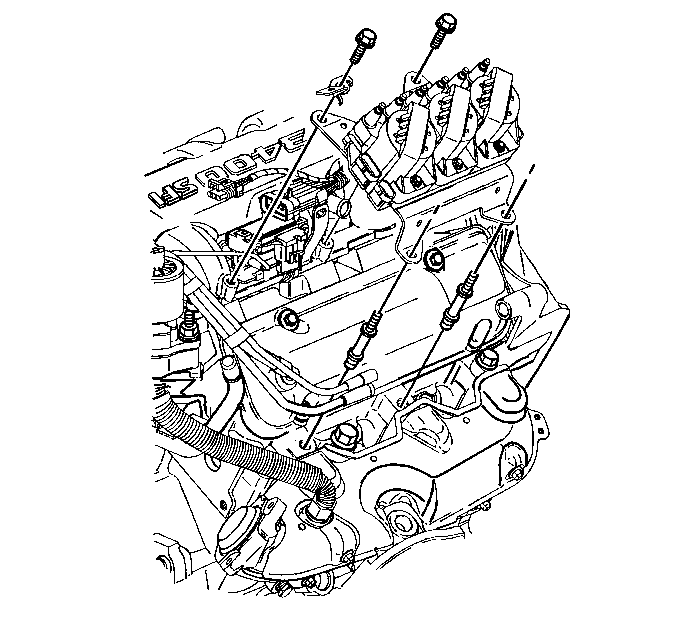

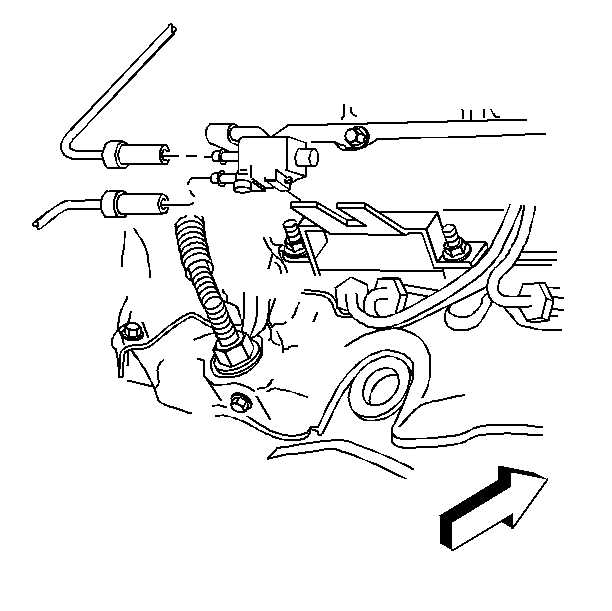

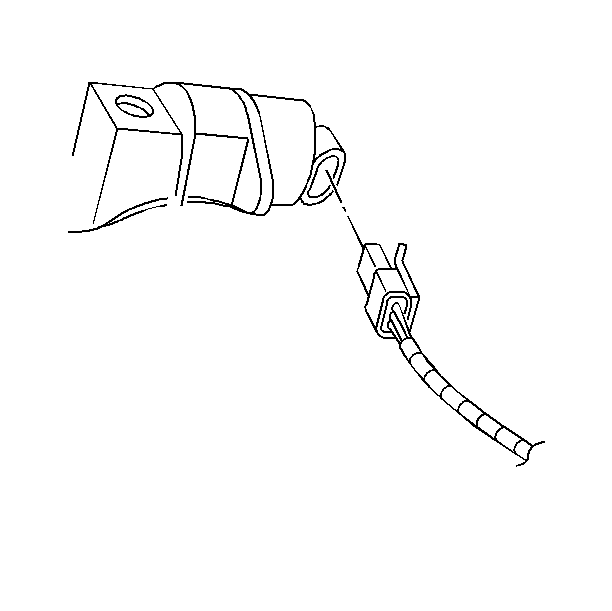
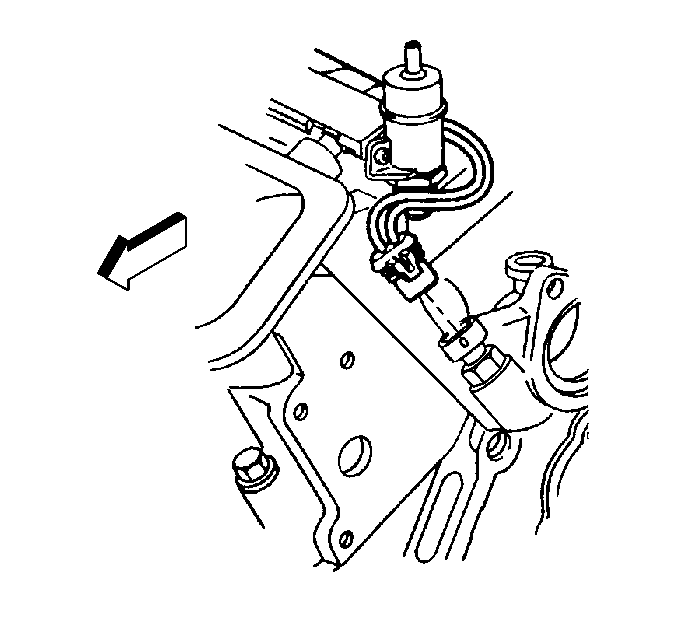

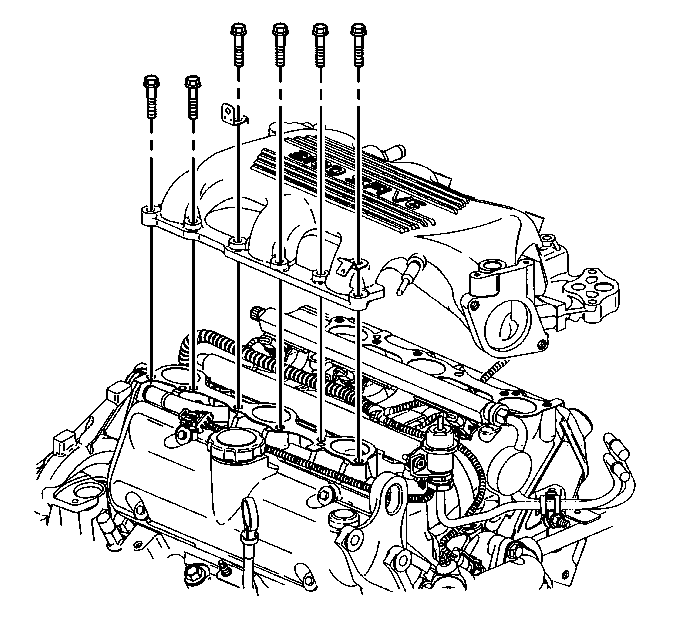
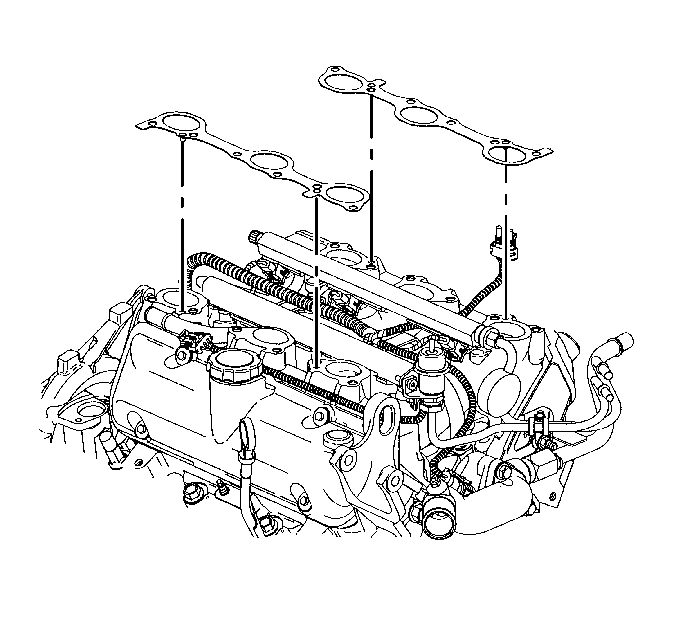
Installation Procedure
- Install the upper intake manifold gaskets on the manifold.
- Apply thread lock GM PN 12345382 to the threads of the bolts.
- Install the bolts (2).
- Install the MAP sensor vacuum line (3).
- Connect the MAP sensor electrical connector.
- Connect the vacuum modulator.
- Install the vacuum hose (1) to the fuel pressure regulator (3) and the crankcase ventilation valve (2).
- Connect the throttle position (TP) sensor.
- Connect the IAC.
- Connect the injector harness.
- Connect the engine coolant temperature (ECT) sensor.
- Connect the camshaft position (CMP) sensor.
- Install the EVAP canister purge solenoid.
- Install the electronic ignition coil and module assembly.
- Install the secondary ignition wires to the spark plugs.
- Install the secondary ignition wires to the harness at the plenum.
- Install the throttle body cable to the throttle body.
- Install the cruise control cable to the throttle body.
- Install the top half of the air cleaner assembly.
- Install the brake vacuum pipe.
- Fill the cooling system. Refer to Cooling System Draining and Filling in Engine Cooling.
- Connect the negative battery cable.
- Inspect for proper fluid levels.
- Inspect for leaks.

Notice: Use the correct fastener in the correct location. Replacement fasteners must be the correct part number for that application. Fasteners requiring replacement or fasteners requiring the use of thread locking compound or sealant are identified in the service procedure. Do not use paints, lubricants, or corrosion inhibitors on fasteners or fastener joint surfaces unless specified. These coatings affect fastener torque and joint clamping force and may damage the fastener. Use the correct tightening sequence and specifications when installing fasteners in order to avoid damage to parts and systems.
Install the upper intake manifold bolts.
Tighten
Tighten the bolts to 25 N·m (18 lb ft).

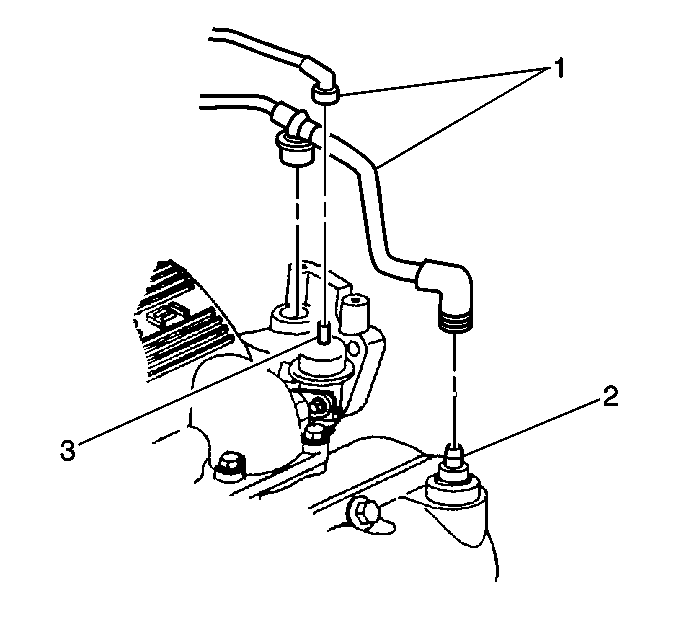




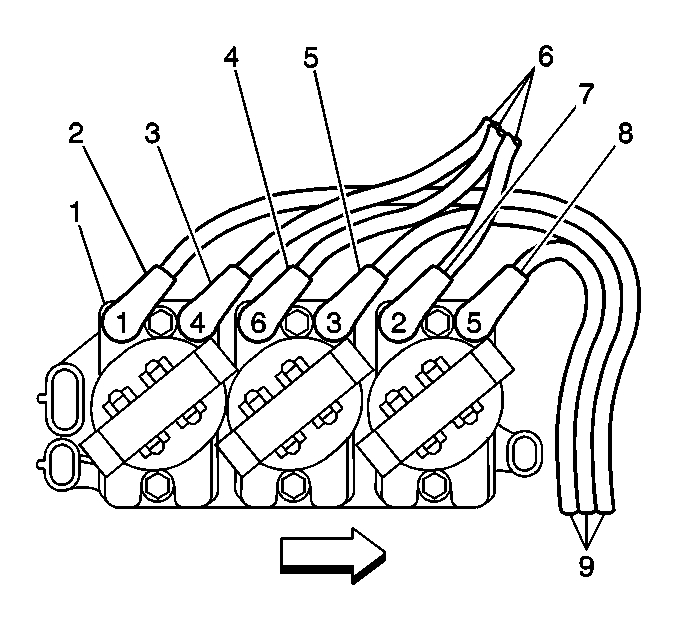
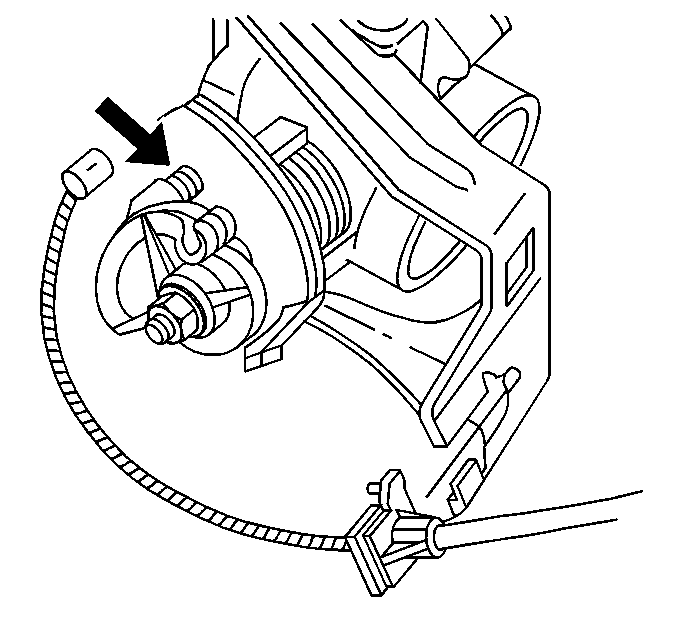

Intake Manifold Replacement Lower
Removal Procedure
Important: This engine uses a sequential multiport fuel injection system. Injector wiring harness connectors must be connected to their appropriate fuel injector or exhaust emissions and engine performance may be seriously affected. For the correct injector wiring harness connector-to-fuel injector connection procedure, refer to Fuel Injector Replacement Engine Controls.
- Disconnect the battery ground (negative) cable.
- Remove the upper intake manifold. Refer to Intake Manifold Replacement .
- Remove the left (front) valve rocker arm cover. Refer to Valve Rocker Arm Cover Replacement .
- Remove the right (rear) valve rocker arm cover. Refer to Valve Rocker Arm Cover Replacement .
- Disconnect the engine coolant temperature (ECT) wiring harness.
- Disconnect and remove the fuel injector and manifold air pressure (MAP) wiring harness.
- Remove the fuel pipe clip bolt.
- Remove the fuel pipe clip.
- Disconnect the fuel feed pipe from the fuel injector rail. Refer to Fuel Hose/Pipes Replacement - Engine Compartment in Engine Controls - 3.1L.
- Disconnect the fuel return pipe from the fuel injector rail. Refer to Fuel Hose/Pipes Replacement - Engine Compartment in Engine Controls - 3.1L.
- Remove the fuel injector rail. Refer to Fuel Injection Fuel Rail Assembly Replacement in Engine Controls - 3.1L.
- Remove the power steering pump from the front engine cover and reposition. Refer to Power Steering Pump Replacement in Power Steering System.
- Disconnect the heater inlet pipe with heater hose from the lower intake manifold and reposition.
- Disconnect the radiator inlet hose from the engine. Refer to Radiator Hose Replacement in Engine Cooling.
- Disconnect the thermostat bypass hose from the thermostat bypass pipe and lower intake manifold pipe.
- Remove the lower intake manifold bolts and DISCARD the bolts.
- Remove the lower intake manifold.
- Remove the lower intake manifold gaskets and seals.
- Clean the lower intake manifold gasket and seal surfaces on the cylinder heads and the engine block.
- Clean the gasket and seal surfaces on the lower intake manifold with degreaser.
- Remove all the loose RTV sealer.
- If replacing the lower intake manifold remove the engine coolant temperature (ECT) sensor.
- If replacing the lower intake manifold remove the water outlet bolts.
- Remove the water outlet.
- If replacing the lower intake manifold remove the thermostat. Refer to Engine Coolant Thermostat Replacement in Engine Cooling.
Caution: Unless directed otherwise, the ignition and start switch must be in the OFF or LOCK position, and all electrical loads must be OFF before servicing any electrical component. Disconnect the negative battery cable to prevent an electrical spark should a tool or equipment come in contact with an exposed electrical terminal. Failure to follow these precautions may result in personal injury and/or damage to the vehicle or its components.
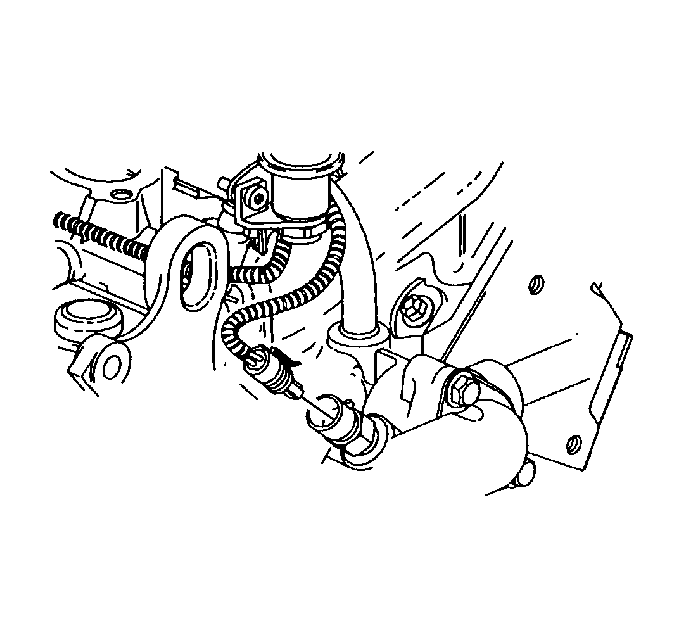
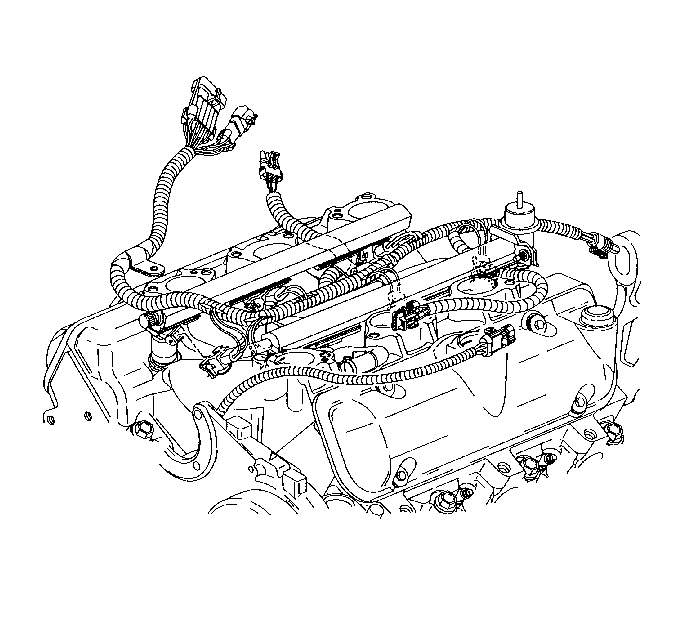
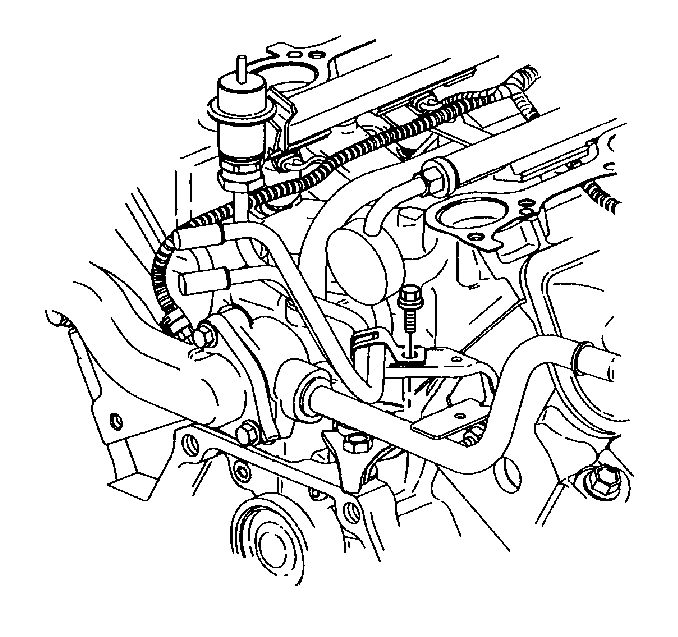

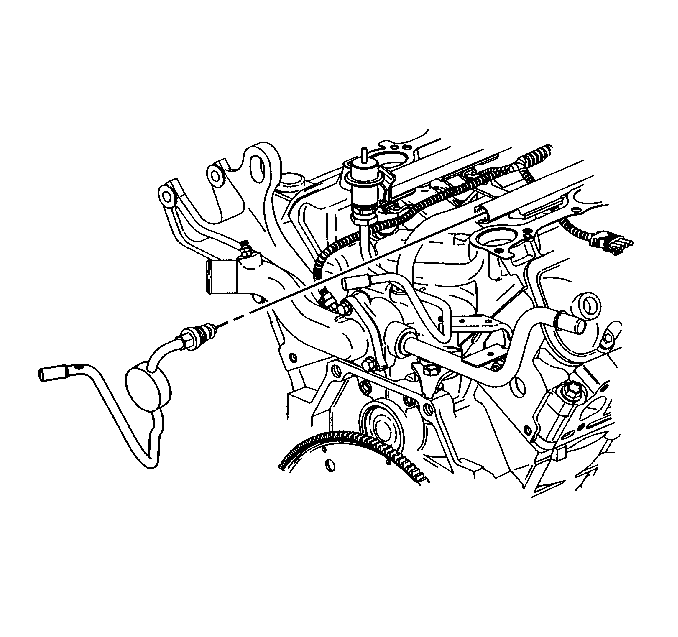
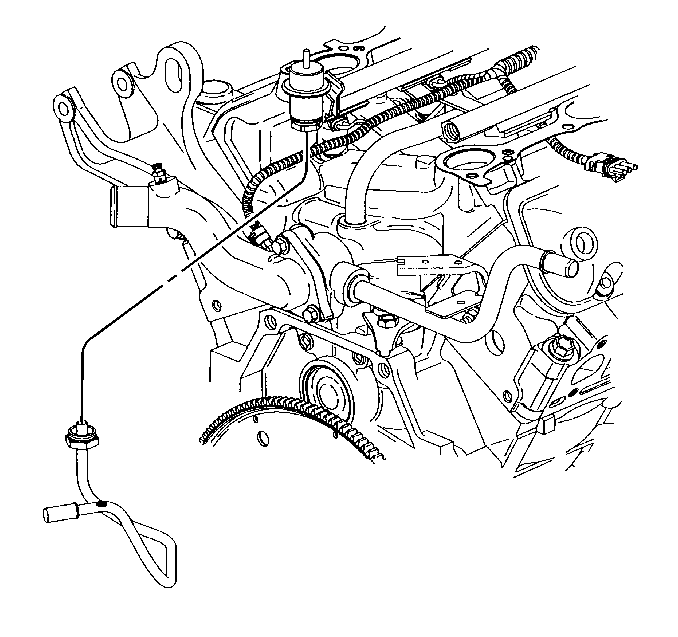
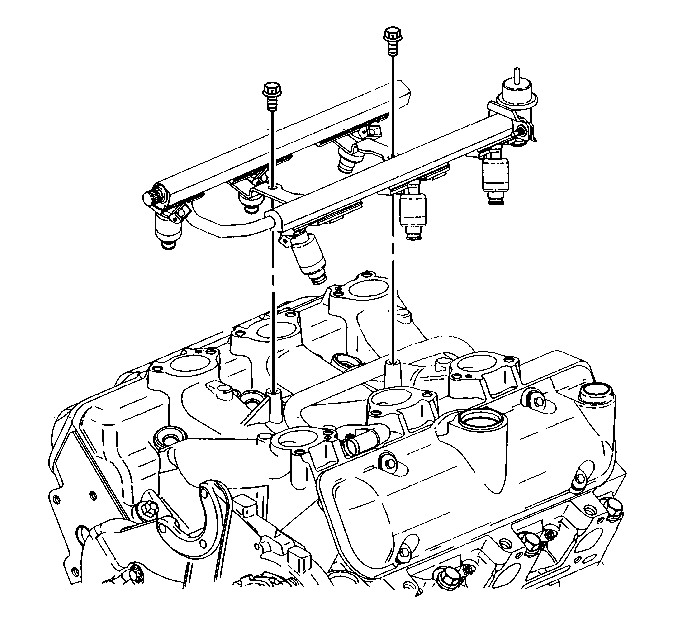
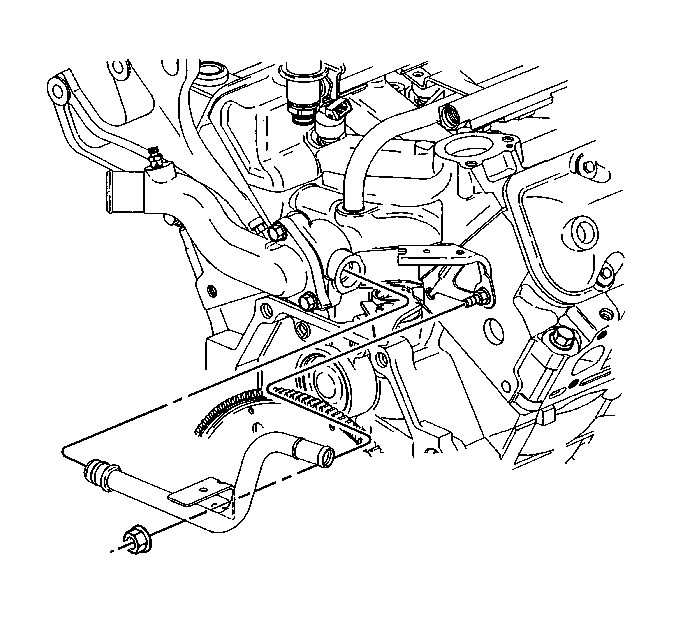
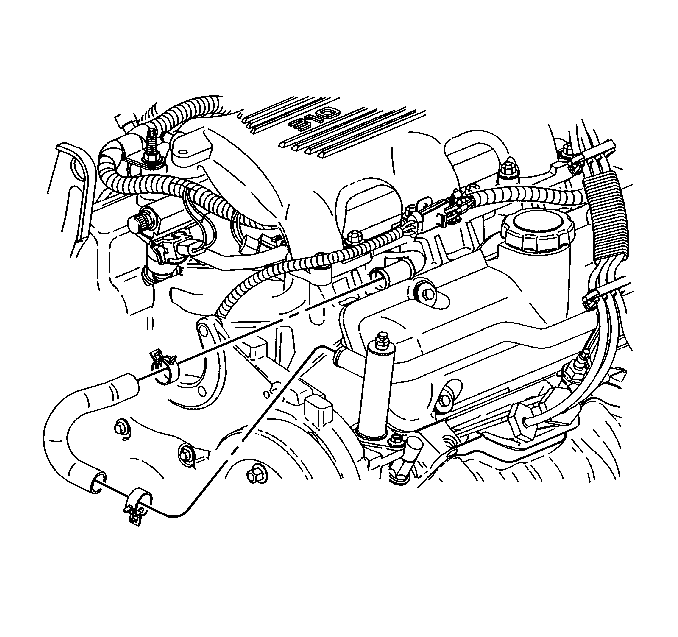
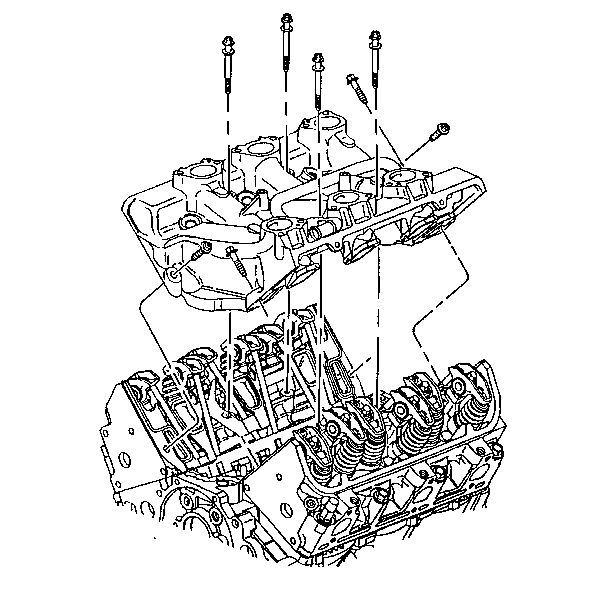
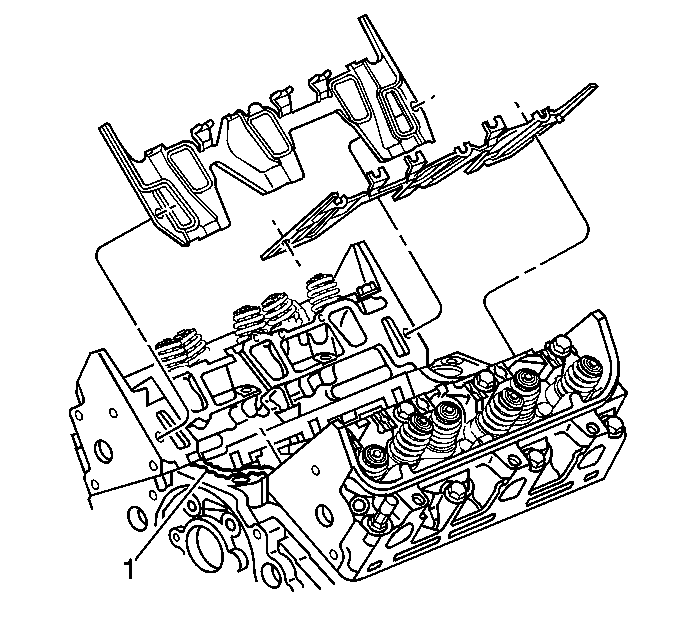
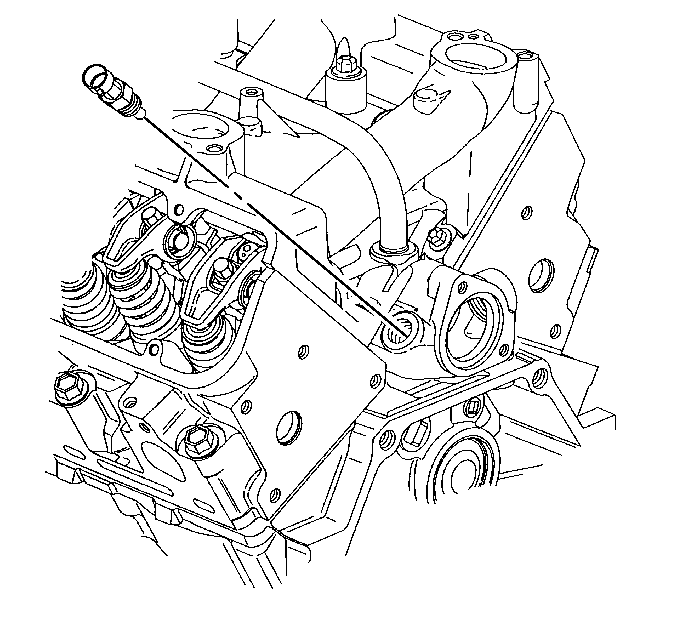
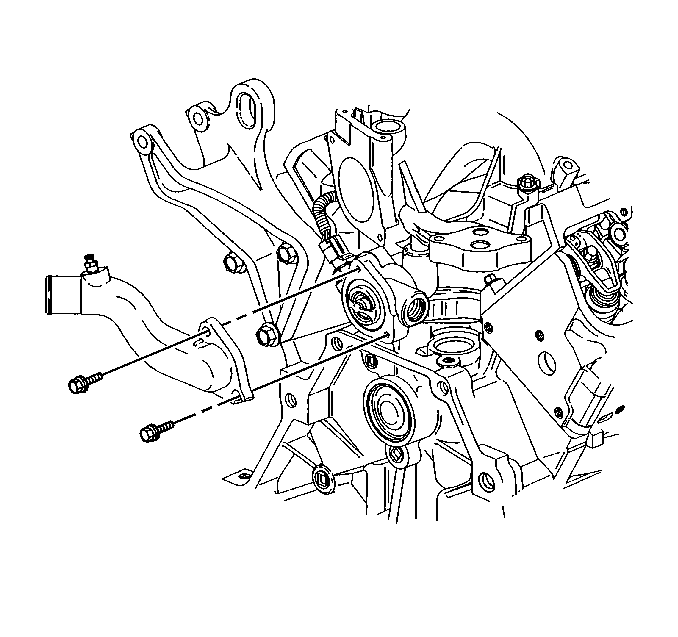
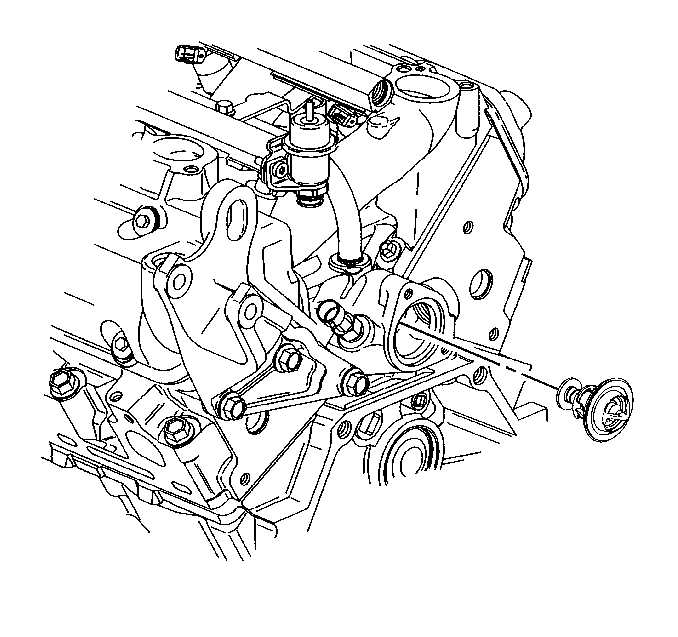
Installation Procedure
- If removed, install the thermostat. Refer to Engine Coolant Thermostat Replacement in Engine Cooling.
- If removed, install the water outlet.
- Install the water outlet bolts.
- If removed, install the engine coolant temperature (ECT) sensor.
- Apply 8-12 mm (0.08-0.11 in) bead of RTV Sealer, GM P/N 12346141 (Canadian P/N 89022195) or equivalent, on each ridge where front and rear of the lower intake manifold contact the engine block (1).
- Install the lower intake manifold gaskets.
- Install the valve rocker arms and pushrods. Refer to Valve Rocker Arm Cover Replacement .
- Install the lower intake manifold.
- Install NEW intake manifold bolts.
- Hand tighten the vertical lower intake manifold bolts.
- Hand tighten the diagonal lower intake manifold bolts.
- Tighten the vertical lower intake manifold bolts (1) to 7 N·m (63 lb in).
- Tighten the diagonal lower intake manifold bolts (2) to 7 N·m (63 lb in).
- Tighten the vertical lower intake manifold bolts (1) to 13 N·m (115 lb in).
- Tighten the diagonal lower intake manifold bolts (2) to 25 N·m (18 lb ft).
- Connect the thermostat bypass hose to the thermostat bypass pipe and lower intake manifold pipe.
- Connect the radiator inlet hose to the engine. Refer to Radiator Hose Replacement in Engine Cooling.
- Connect the heater inlet pipe and heater hose to the lower intake manifold.
- Install the power steering pump to the front engine cover. Refer to Power Steering Pump Replacement in Power Steering System.
- Install the fuel injector rail. Refer to Fuel Injection Fuel Rail Assembly Replacement in Engine Controls - 3.1L.
- Connect the fuel return pipe to the fuel injector rail. Refer to Fuel Hose/Pipes Replacement - Engine Compartment in Engine Controls - 3.1L.
- Connect the fuel feed pipe to the fuel injector rail. Refer to Fuel Hose/Pipes Replacement - Engine Compartment in Engine Controls - 3.1L.
- Install the fuel pipe clip.
- Install the fuel pipe clip bolt.
- Install and connect the fuel injector and manifold air pressure (MAP) wiring harness.
- Connect the engine coolant temperature (ECT) wiring harness.
- Install the upper intake manifold. Refer to Intake Manifold Replacement .
- Connect the battery ground (negative) cable.


Notice: Use the correct fastener in the correct location. Replacement fasteners must be the correct part number for that application. Fasteners requiring replacement or fasteners requiring the use of thread locking compound or sealant are identified in the service procedure. Do not use paints, lubricants, or corrosion inhibitors on fasteners or fastener joint surfaces unless specified. These coatings affect fastener torque and joint clamping force and may damage the fastener. Use the correct tightening sequence and specifications when installing fasteners in order to avoid damage to parts and systems.
Tighten
Tighten the water outlet bolts to 25 N·m (18 lb ft).

Tighten
Tighten the engine coolant temperature (ECT) sensor to 23 N·m (17 lb ft).


Notice: An oil leak may result if the vertical bolts are not tightened before the diagonal bolts.
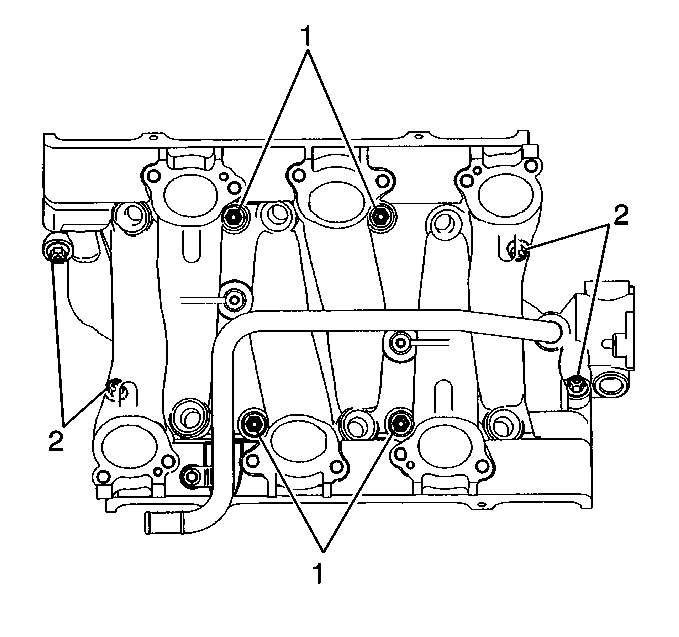
Tighten







Tighten
Tighten the fuel pipe clip bolt to 8 N·m (71 lb in).


Caution: Unless directed otherwise, the ignition and start switch must be in the OFF or LOCK position, and all electrical loads must be OFF before servicing any electrical component. Disconnect the negative battery cable to prevent an electrical spark should a tool or equipment come in contact with an exposed electrical terminal. Failure to follow these precautions may result in personal injury and/or damage to the vehicle or its components.
